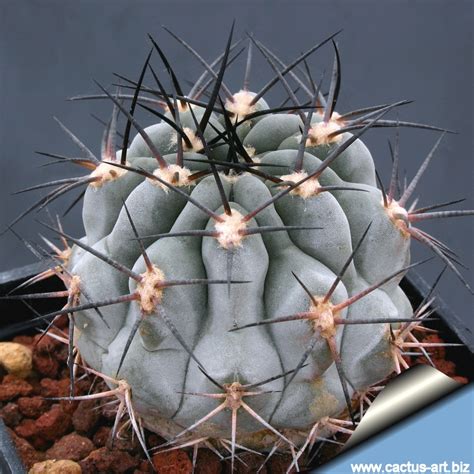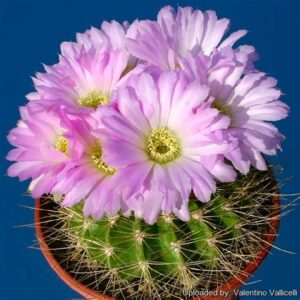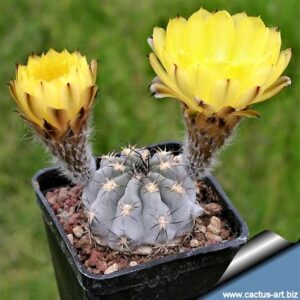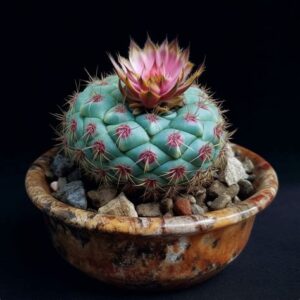Acanthocalycium glaucum rubriflora, a striking variety of the Acanthocalycium species, engenders a myriad of curiosities among cactus enthusiasts. Known for its vibrant aesthetics and unique growing requirements, this plant captivates both novice and seasoned gardeners alike. But what is it about this particular cultivar that makes it so special, and what challenges might one face when caring for it? Let’s unravel the mysteries surrounding Acanthocalycium glaucum rubriflora.
The genus Acanthocalycium belongs to the family Cactaceae, and this species specifically originated in the arid landscapes of Argentina. While Acanthocalycium glaucum is recognized for its alluring appearance, the rubriflora variant boasts an even more distinguished profile, with its flamboyant red blooms offering a fiery contrast to the bluish-gray body of the plant. This striking dichotomy prompts the question: how does the vibrant coloration of this cactus adapt to its natural environment?
Located primarily in rocky terrains, Acanthocalycium glaucum rubriflora has evolved remarkable adaptations that allow it to thrive in harsh conditions. Its thick, fleshy body is a water reservoir, enabling it to endure prolonged periods of drought. The plant’s spines, while visually appealing, also serve a utilitarian purpose; they protect the plant from herbivores and help to reduce water loss by creating a microclimate around the cactus. However, as enchanting as it may be, growing this cactus can pose challenges due to its specific cultivation needs and susceptibility to environmental stressors.
In understanding the ecology of Acanthocalycium glaucum rubriflora, we discern that its natural habitat informs much of its care requirements. Consequently, replicating its native conditions becomes paramount for successful cultivation.
Understanding Optimal Growing Conditions
For those who wish to cultivate Acanthocalycium glaucum rubriflora, knowledge of its preferred growing conditions is essential. Native to the dry, rocky regions of Argentina, this cactus requires ample sunlight to flourish. Ideally, it should receive at least six hours of direct sunlight daily. Insufficient light can result in elongated growth and reduce flowering potential.
Temperature is another vital factor. Acanthocalycium glaucum rubriflora thrives in warm conditions, ideally between 70°F and 85°F during the growing season. However, it can tolerate cooler temperatures, falling to about 50°F during the winter months, although it should be protected from frost. Understanding this temperature range prompts the question: how can one effectively create a microenvironment that simulates these warming conditions during fluctuating seasons?
Watering habits also require careful consideration. During the active growing season, generally from spring to early autumn, this species appreciates moderate watering. Soil should be allowed to dry out between waterings to prevent root rot, a common affliction among cacti. Adopting a “soak and dry” watering technique can effectively meet its hydration needs. As fall approaches, watering should be decreased, allowing the plant to enter dormancy. Nevertheless, monitoring moisture levels becomes crucial, particularly in indoor settings where humidity and airflow differ from its native habitat. Could this delicate balance of watering be the defining challenge of keeping this cactus vibrant and healthy?
The Right Soil Mix for Success
Choosing the appropriate soil is paramount for cultivating Acanthocalycium glaucum rubriflora. A well-draining, porous potting mix is ideal. A combination of potting soil, pumice, and sand creates the perfect medium for aeration and drainage, ensuring the roots receive adequate oxygen while avoiding waterlogged conditions. Specialized cactus mixes available from nurseries can also serve as a suitable substrate.
Repotting should be performed every couple of years, particularly if you notice the plant becoming root-bound. Spring is the best time for this process since it aligns with the plant’s active growing phase. Utilizing a pot with drainage holes will further aid in preventing excess moisture retention. Yet, there may be a dilemma: how often should one assess the health of the roots, and what signs indicate that repotting is necessary?
Fertilization Fundamentals
To encourage optimal growth and vibrant blooms, fertilization plays a crucial role within the cultivation of Acanthocalycium glaucum rubriflora. During the growing season, applying a balanced, diluted cactus fertilizer approximately once a month can provide essential nutrients for thriving. Look for formulations high in potassium, as this element promotes flowering and overall vigor.
In contrast, during dormancy, no fertilization is required. The challenge then lies in timing the fertilization cycle appropriately to coincide with the active growth phase without causing undue stress to the plant. How can a gardener become attuned to the cactus’s growth rhythms and ensure a healthy, blooming specimen?
Pest Management in the Landscape of Challenges
Even the most careful cultivators may encounter pests that pose a threat to the vitality of Acanthocalycium glaucum rubriflora. Mealybugs and spider mites are two common adversaries that can undermine the health of the plant. Regular inspections for these pests are imperative for early detection and intervention.
If detected, removing mealybugs with a cotton swab dipped in alcohol can effectively control these pests. For spider mites, increasing humidity around the plant can deter their presence. Using insecticidal soap is also a viable option, though it’s essential to follow the product’s specifications carefully. The question remains: how can one foster a proactive care routine to prevent pest infestations before they take hold?
Encouraging Blossoms: The Wonder of Flowers
The ultimate reward of nurturing Acanthocalycium glaucum rubriflora is the breathtaking blooms it produces. Typically appearing in mid to late summer, the flowers are vibrant red or orange, displaying an enticing contrast against the plant’s succulent body. Each flower opens during the day and closes at night, a behavior intrinsic to many cacti. For those hoping to enhance the likelihood of bloom production, ensuring optimal light, appropriate watering, and nutrient application becomes indispensable.
However, not all cacti bloom yearly, and a myriad of factors can influence flowering. This introduces an intriguing challenge: how does one cultivate patience while awaiting the floral spectacle? Can subtle changes in care routines influence the timing and quality of these blooms?
In conclusion, Acanthocalycium glaucum rubriflora stands as a testament to the beauty and complexity of cacti. From selecting appropriate soil and watering techniques to managing pests, myriad factors dictate successful cultivation. Through careful observation and a willingness to adapt, one may uncover the secrets of this stunning cactus and perhaps face the challenges it presents with confidence and expertise. As with any endeavor in horticulture, the relationship between gardener and plant becomes a journey filled with learning, patience, and, ultimately, reward.





Leave a Comment